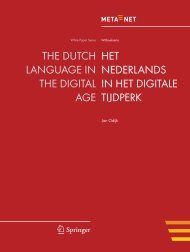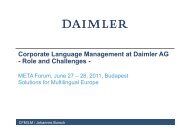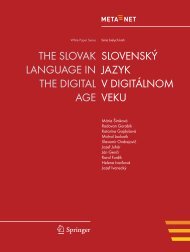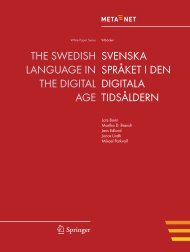Norsk i den digitale tidsalderen - Meta-Net
Norsk i den digitale tidsalderen - Meta-Net
Norsk i den digitale tidsalderen - Meta-Net
Create successful ePaper yourself
Turn your PDF publications into a flip-book with our unique Google optimized e-Paper software.
tion. According to one estimate, the European market<br />
for translation, interpretation, soware localisation and<br />
website globalisation was €8.4 billion in 2008 and is<br />
expected to grow by 10% per annum [9]. Yet this fig-<br />
ure covers just a small proportion of current and future<br />
needs in communicating between languages. e most<br />
compelling solution for ensuring the breadth and depth<br />
of language usage in Europe tomorrow is to use appro-<br />
priate technology, just as we use technology to solve our<br />
transport and energy needs among others.<br />
Language technology targeting all forms of written text<br />
and spoken discourse can help people to collaborate,<br />
conduct business, share knowledge and participate in<br />
social and political debate regardless of language barri-<br />
ers and computer skills. It oen operates invisibly inside<br />
complex soware systems to help us already today to:<br />
find information with a search engine;<br />
check spelling and grammar in a word processor;<br />
view product recommendations in an online shop;<br />
follow the spoken directions of a navigation system;<br />
translate web pages via an online service.<br />
Language technology consists of a number of core ap-<br />
plications that enable processes within a larger applica-<br />
tion framework. e purpose of the META-NET lan-<br />
guage white papers is to focus on how ready these core<br />
enabling technologies are for each European language.<br />
Europe needs robust and affordable language<br />
technology for all European languages.<br />
To maintain our position in the frontline of global inno-<br />
vation, Europe will need language technology, tailored<br />
to all European languages, that is robust and affordable<br />
and can be tightly integrated within key soware envi-<br />
ronments. Without language technology, we will not be<br />
able to achieve a really effective interactive, multimedia<br />
and multilingual user experience in the near future.<br />
2.4 OPPORTUNITIES FOR<br />
LANGUAGE TECHNOLOGY<br />
In the world of print, the technology breakthrough was<br />
the rapid duplication of an image of a text using a suit-<br />
ably powered printing press. Human beings had to do<br />
the hard work of looking up, assessing, translating, and<br />
summarising knowledge. We had to wait until Edison<br />
to record spoken language – and again his technology<br />
simply made analogue copies.<br />
Language technology can now simplify and automate<br />
the processes of translation, content production, and<br />
knowledge management for all European languages. It<br />
can also empower intuitive speech-based interfaces for<br />
household electronics, machinery, vehicles, computers<br />
and robots. Real-world commercial and industrial ap-<br />
plications are still in the early stages of development,<br />
yet R&D achievements are creating a genuine window<br />
of opportunity. For example, machine translation is al-<br />
ready reasonably accurate in specific domains, and ex-<br />
perimental applications provide multilingual informa-<br />
tion and knowledge management, as well as content<br />
production, in many European languages.<br />
As with most technologies, the first language applica-<br />
tions such as voice-based user interfaces and dialogue<br />
systems were developed for specialised domains, and<br />
oen exhibit limited performance. However, there are<br />
huge market opportunities in the education and enter-<br />
tainment industries for integrating language technolo-<br />
gies into games, edutainment packages, libraries, simu-<br />
lation environments and training programs. Mobile in-<br />
formation services, computer-assisted language learning<br />
soware, eLearning environments, self-assessment tools<br />
and plagiarism detection soware are just some of the<br />
application areas in which language technology can play<br />
an important role. e popularity of social media ap-<br />
plications like Twitter and Facebook suggest a need for<br />
sophisticated language technologies that can monitor<br />
posts, summarise discussions, suggest opinion trends,<br />
42








